Building Regulation Studies 1: Fire Regulations Homework Analysis
VerifiedAdded on 2023/06/05
|11
|2930
|229
Homework Assignment
AI Summary
This document presents a comprehensive analysis of fire regulations within the context of Australian building codes, specifically addressing the Building Code of Australia (BCA). The assignment solution covers various aspects of fire safety, including building classifications (Class 1a, 2, 6, and 8), rise in storeys (RIS) calculations, and the determination of fire-resisting construction types. It explores the methods for assessing fire exposure of walls, the fire-resisting requirements for external walls, and the necessity for isolating exits in multi-story buildings. Furthermore, the document provides detailed calculations for aggregate exit widths and examines emergency lighting and exit sign requirements for different building types. Finally, it addresses fire hydrant system installations, ensuring compliance with relevant Australian standards. The document highlights key concepts such as deemed-to-satisfy (DTS) provisions, functional statements, performance requirements, and building solutions, providing a complete understanding of fire safety regulations in building design and construction.
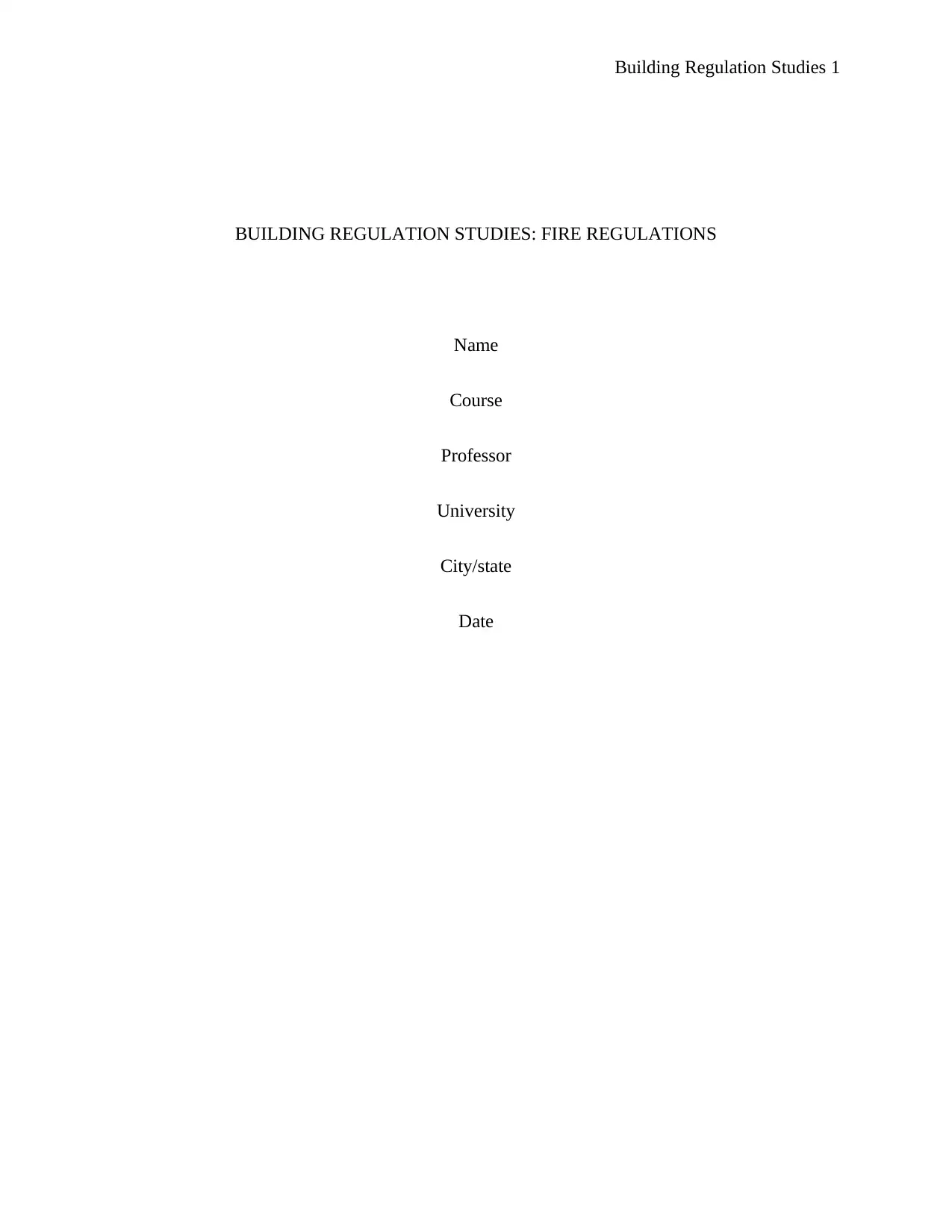
Building Regulation Studies 1
BUILDING REGULATION STUDIES: FIRE REGULATIONS
Name
Course
Professor
University
City/state
Date
BUILDING REGULATION STUDIES: FIRE REGULATIONS
Name
Course
Professor
University
City/state
Date
Paraphrase This Document
Need a fresh take? Get an instant paraphrase of this document with our AI Paraphraser
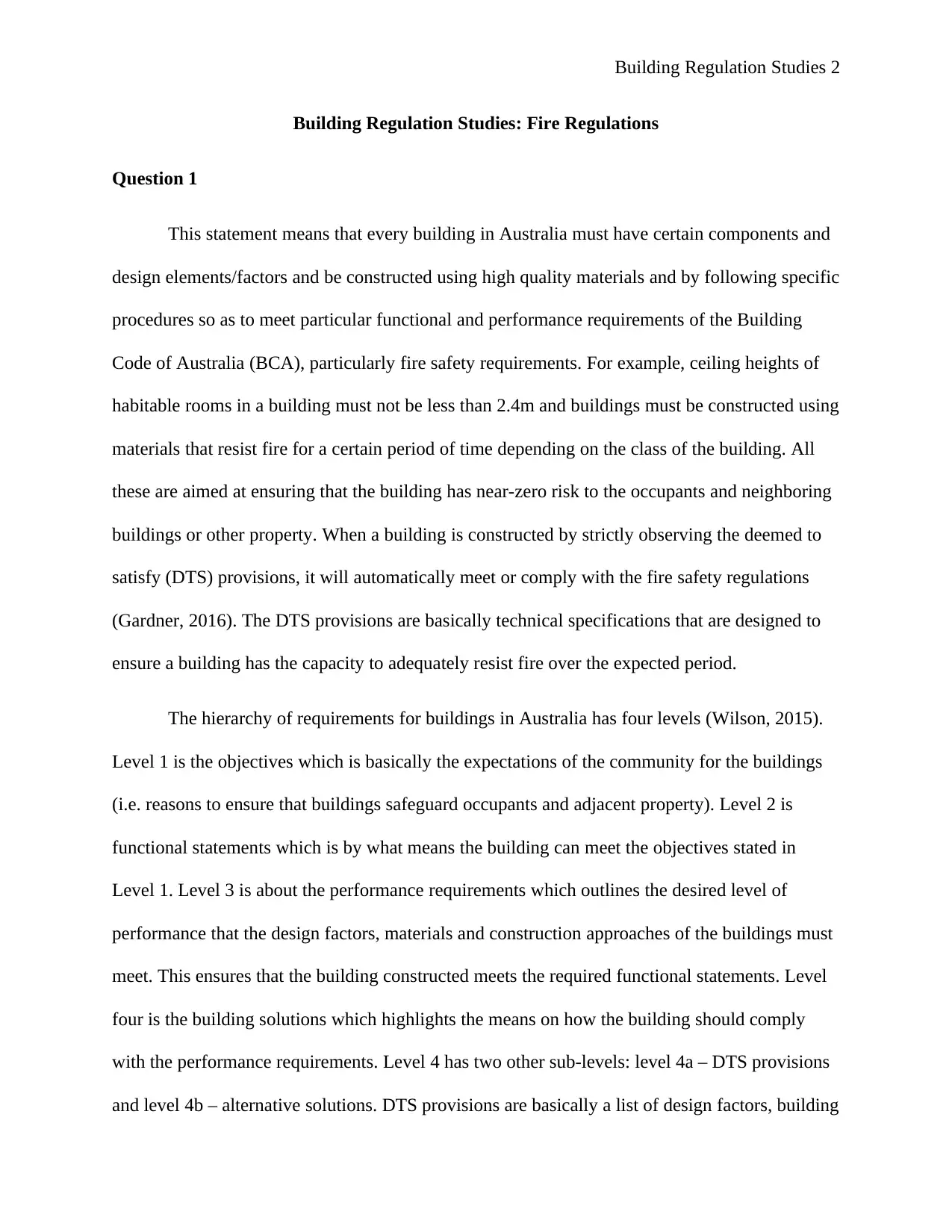
Building Regulation Studies 2
Building Regulation Studies: Fire Regulations
Question 1
This statement means that every building in Australia must have certain components and
design elements/factors and be constructed using high quality materials and by following specific
procedures so as to meet particular functional and performance requirements of the Building
Code of Australia (BCA), particularly fire safety requirements. For example, ceiling heights of
habitable rooms in a building must not be less than 2.4m and buildings must be constructed using
materials that resist fire for a certain period of time depending on the class of the building. All
these are aimed at ensuring that the building has near-zero risk to the occupants and neighboring
buildings or other property. When a building is constructed by strictly observing the deemed to
satisfy (DTS) provisions, it will automatically meet or comply with the fire safety regulations
(Gardner, 2016). The DTS provisions are basically technical specifications that are designed to
ensure a building has the capacity to adequately resist fire over the expected period.
The hierarchy of requirements for buildings in Australia has four levels (Wilson, 2015).
Level 1 is the objectives which is basically the expectations of the community for the buildings
(i.e. reasons to ensure that buildings safeguard occupants and adjacent property). Level 2 is
functional statements which is by what means the building can meet the objectives stated in
Level 1. Level 3 is about the performance requirements which outlines the desired level of
performance that the design factors, materials and construction approaches of the buildings must
meet. This ensures that the building constructed meets the required functional statements. Level
four is the building solutions which highlights the means on how the building should comply
with the performance requirements. Level 4 has two other sub-levels: level 4a – DTS provisions
and level 4b – alternative solutions. DTS provisions are basically a list of design factors, building
Building Regulation Studies: Fire Regulations
Question 1
This statement means that every building in Australia must have certain components and
design elements/factors and be constructed using high quality materials and by following specific
procedures so as to meet particular functional and performance requirements of the Building
Code of Australia (BCA), particularly fire safety requirements. For example, ceiling heights of
habitable rooms in a building must not be less than 2.4m and buildings must be constructed using
materials that resist fire for a certain period of time depending on the class of the building. All
these are aimed at ensuring that the building has near-zero risk to the occupants and neighboring
buildings or other property. When a building is constructed by strictly observing the deemed to
satisfy (DTS) provisions, it will automatically meet or comply with the fire safety regulations
(Gardner, 2016). The DTS provisions are basically technical specifications that are designed to
ensure a building has the capacity to adequately resist fire over the expected period.
The hierarchy of requirements for buildings in Australia has four levels (Wilson, 2015).
Level 1 is the objectives which is basically the expectations of the community for the buildings
(i.e. reasons to ensure that buildings safeguard occupants and adjacent property). Level 2 is
functional statements which is by what means the building can meet the objectives stated in
Level 1. Level 3 is about the performance requirements which outlines the desired level of
performance that the design factors, materials and construction approaches of the buildings must
meet. This ensures that the building constructed meets the required functional statements. Level
four is the building solutions which highlights the means on how the building should comply
with the performance requirements. Level 4 has two other sub-levels: level 4a – DTS provisions
and level 4b – alternative solutions. DTS provisions are basically a list of design factors, building
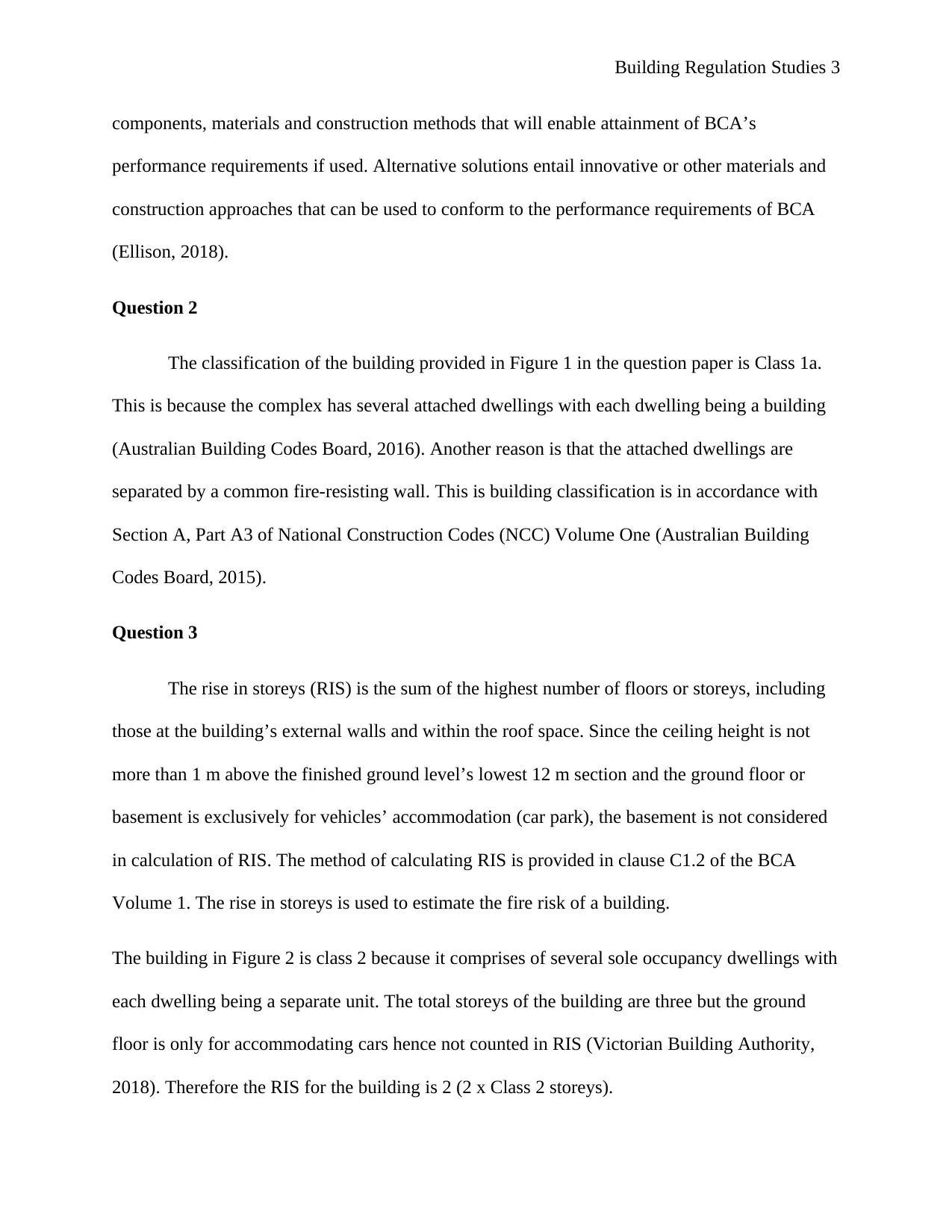
Building Regulation Studies 3
components, materials and construction methods that will enable attainment of BCA’s
performance requirements if used. Alternative solutions entail innovative or other materials and
construction approaches that can be used to conform to the performance requirements of BCA
(Ellison, 2018).
Question 2
The classification of the building provided in Figure 1 in the question paper is Class 1a.
This is because the complex has several attached dwellings with each dwelling being a building
(Australian Building Codes Board, 2016). Another reason is that the attached dwellings are
separated by a common fire-resisting wall. This is building classification is in accordance with
Section A, Part A3 of National Construction Codes (NCC) Volume One (Australian Building
Codes Board, 2015).
Question 3
The rise in storeys (RIS) is the sum of the highest number of floors or storeys, including
those at the building’s external walls and within the roof space. Since the ceiling height is not
more than 1 m above the finished ground level’s lowest 12 m section and the ground floor or
basement is exclusively for vehicles’ accommodation (car park), the basement is not considered
in calculation of RIS. The method of calculating RIS is provided in clause C1.2 of the BCA
Volume 1. The rise in storeys is used to estimate the fire risk of a building.
The building in Figure 2 is class 2 because it comprises of several sole occupancy dwellings with
each dwelling being a separate unit. The total storeys of the building are three but the ground
floor is only for accommodating cars hence not counted in RIS (Victorian Building Authority,
2018). Therefore the RIS for the building is 2 (2 x Class 2 storeys).
components, materials and construction methods that will enable attainment of BCA’s
performance requirements if used. Alternative solutions entail innovative or other materials and
construction approaches that can be used to conform to the performance requirements of BCA
(Ellison, 2018).
Question 2
The classification of the building provided in Figure 1 in the question paper is Class 1a.
This is because the complex has several attached dwellings with each dwelling being a building
(Australian Building Codes Board, 2016). Another reason is that the attached dwellings are
separated by a common fire-resisting wall. This is building classification is in accordance with
Section A, Part A3 of National Construction Codes (NCC) Volume One (Australian Building
Codes Board, 2015).
Question 3
The rise in storeys (RIS) is the sum of the highest number of floors or storeys, including
those at the building’s external walls and within the roof space. Since the ceiling height is not
more than 1 m above the finished ground level’s lowest 12 m section and the ground floor or
basement is exclusively for vehicles’ accommodation (car park), the basement is not considered
in calculation of RIS. The method of calculating RIS is provided in clause C1.2 of the BCA
Volume 1. The rise in storeys is used to estimate the fire risk of a building.
The building in Figure 2 is class 2 because it comprises of several sole occupancy dwellings with
each dwelling being a separate unit. The total storeys of the building are three but the ground
floor is only for accommodating cars hence not counted in RIS (Victorian Building Authority,
2018). Therefore the RIS for the building is 2 (2 x Class 2 storeys).
⊘ This is a preview!⊘
Do you want full access?
Subscribe today to unlock all pages.

Trusted by 1+ million students worldwide
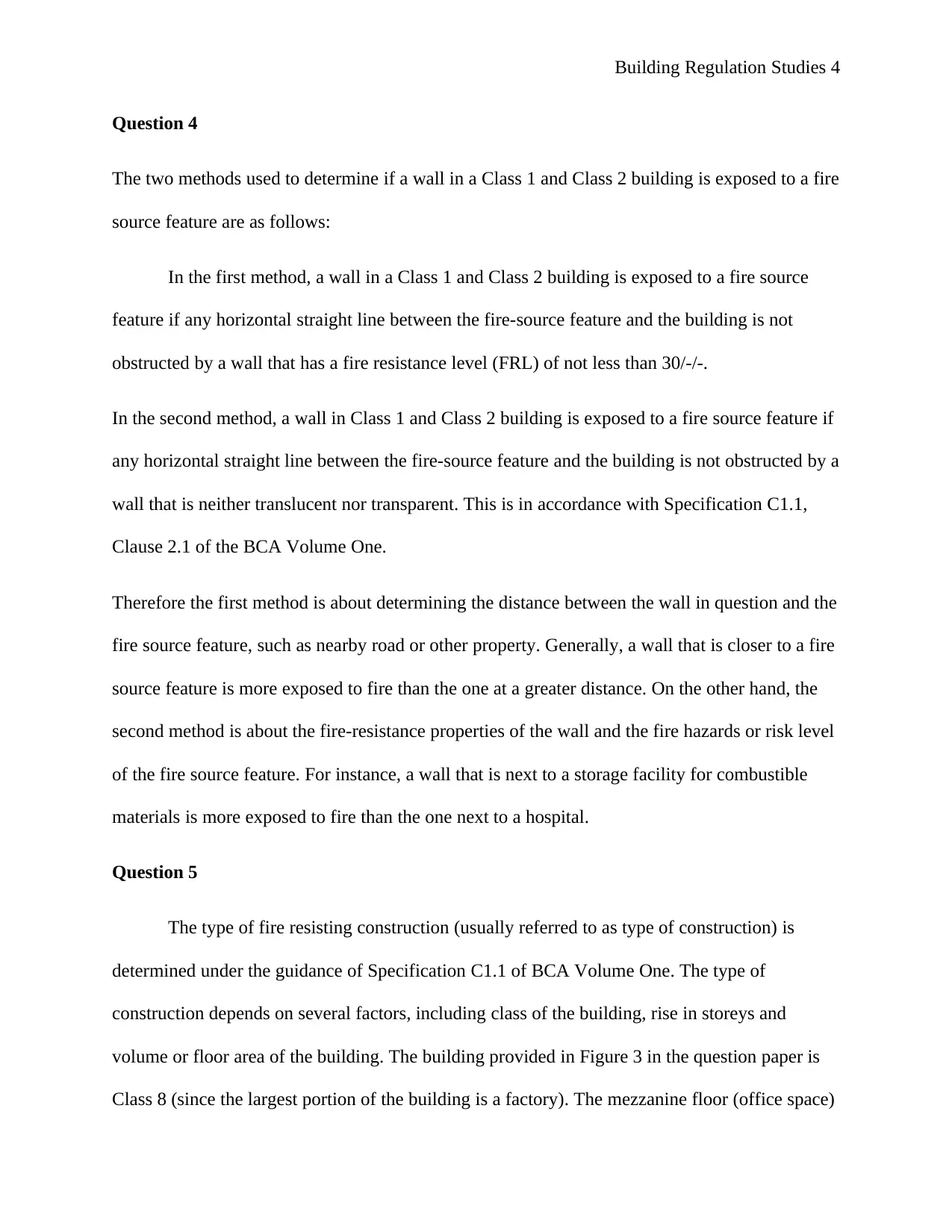
Building Regulation Studies 4
Question 4
The two methods used to determine if a wall in a Class 1 and Class 2 building is exposed to a fire
source feature are as follows:
In the first method, a wall in a Class 1 and Class 2 building is exposed to a fire source
feature if any horizontal straight line between the fire-source feature and the building is not
obstructed by a wall that has a fire resistance level (FRL) of not less than 30/-/-.
In the second method, a wall in Class 1 and Class 2 building is exposed to a fire source feature if
any horizontal straight line between the fire-source feature and the building is not obstructed by a
wall that is neither translucent nor transparent. This is in accordance with Specification C1.1,
Clause 2.1 of the BCA Volume One.
Therefore the first method is about determining the distance between the wall in question and the
fire source feature, such as nearby road or other property. Generally, a wall that is closer to a fire
source feature is more exposed to fire than the one at a greater distance. On the other hand, the
second method is about the fire-resistance properties of the wall and the fire hazards or risk level
of the fire source feature. For instance, a wall that is next to a storage facility for combustible
materials is more exposed to fire than the one next to a hospital.
Question 5
The type of fire resisting construction (usually referred to as type of construction) is
determined under the guidance of Specification C1.1 of BCA Volume One. The type of
construction depends on several factors, including class of the building, rise in storeys and
volume or floor area of the building. The building provided in Figure 3 in the question paper is
Class 8 (since the largest portion of the building is a factory). The mezzanine floor (office space)
Question 4
The two methods used to determine if a wall in a Class 1 and Class 2 building is exposed to a fire
source feature are as follows:
In the first method, a wall in a Class 1 and Class 2 building is exposed to a fire source
feature if any horizontal straight line between the fire-source feature and the building is not
obstructed by a wall that has a fire resistance level (FRL) of not less than 30/-/-.
In the second method, a wall in Class 1 and Class 2 building is exposed to a fire source feature if
any horizontal straight line between the fire-source feature and the building is not obstructed by a
wall that is neither translucent nor transparent. This is in accordance with Specification C1.1,
Clause 2.1 of the BCA Volume One.
Therefore the first method is about determining the distance between the wall in question and the
fire source feature, such as nearby road or other property. Generally, a wall that is closer to a fire
source feature is more exposed to fire than the one at a greater distance. On the other hand, the
second method is about the fire-resistance properties of the wall and the fire hazards or risk level
of the fire source feature. For instance, a wall that is next to a storage facility for combustible
materials is more exposed to fire than the one next to a hospital.
Question 5
The type of fire resisting construction (usually referred to as type of construction) is
determined under the guidance of Specification C1.1 of BCA Volume One. The type of
construction depends on several factors, including class of the building, rise in storeys and
volume or floor area of the building. The building provided in Figure 3 in the question paper is
Class 8 (since the largest portion of the building is a factory). The mezzanine floor (office space)
Paraphrase This Document
Need a fresh take? Get an instant paraphrase of this document with our AI Paraphraser
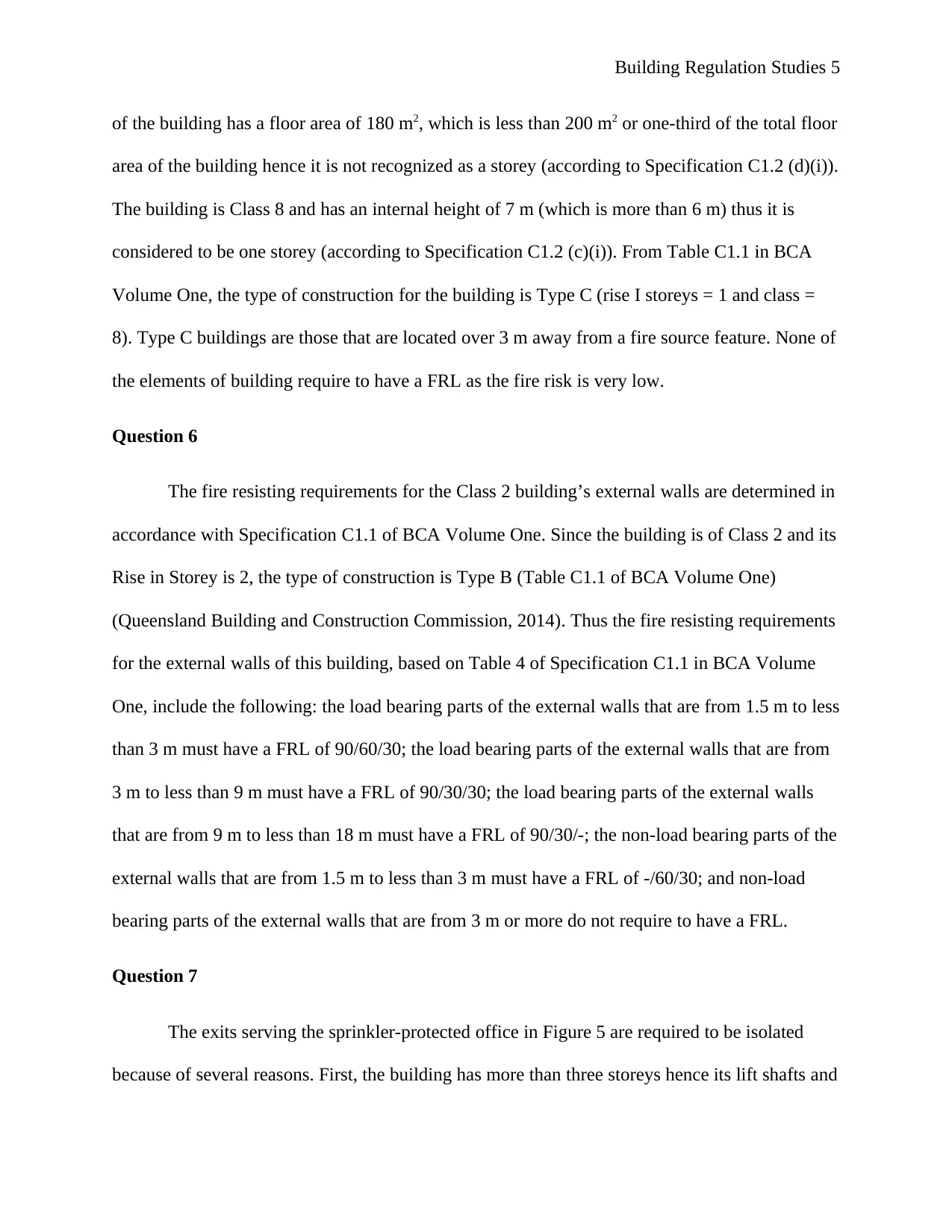
Building Regulation Studies 5
of the building has a floor area of 180 m2, which is less than 200 m2 or one-third of the total floor
area of the building hence it is not recognized as a storey (according to Specification C1.2 (d)(i)).
The building is Class 8 and has an internal height of 7 m (which is more than 6 m) thus it is
considered to be one storey (according to Specification C1.2 (c)(i)). From Table C1.1 in BCA
Volume One, the type of construction for the building is Type C (rise I storeys = 1 and class =
8). Type C buildings are those that are located over 3 m away from a fire source feature. None of
the elements of building require to have a FRL as the fire risk is very low.
Question 6
The fire resisting requirements for the Class 2 building’s external walls are determined in
accordance with Specification C1.1 of BCA Volume One. Since the building is of Class 2 and its
Rise in Storey is 2, the type of construction is Type B (Table C1.1 of BCA Volume One)
(Queensland Building and Construction Commission, 2014). Thus the fire resisting requirements
for the external walls of this building, based on Table 4 of Specification C1.1 in BCA Volume
One, include the following: the load bearing parts of the external walls that are from 1.5 m to less
than 3 m must have a FRL of 90/60/30; the load bearing parts of the external walls that are from
3 m to less than 9 m must have a FRL of 90/30/30; the load bearing parts of the external walls
that are from 9 m to less than 18 m must have a FRL of 90/30/-; the non-load bearing parts of the
external walls that are from 1.5 m to less than 3 m must have a FRL of -/60/30; and non-load
bearing parts of the external walls that are from 3 m or more do not require to have a FRL.
Question 7
The exits serving the sprinkler-protected office in Figure 5 are required to be isolated
because of several reasons. First, the building has more than three storeys hence its lift shafts and
of the building has a floor area of 180 m2, which is less than 200 m2 or one-third of the total floor
area of the building hence it is not recognized as a storey (according to Specification C1.2 (d)(i)).
The building is Class 8 and has an internal height of 7 m (which is more than 6 m) thus it is
considered to be one storey (according to Specification C1.2 (c)(i)). From Table C1.1 in BCA
Volume One, the type of construction for the building is Type C (rise I storeys = 1 and class =
8). Type C buildings are those that are located over 3 m away from a fire source feature. None of
the elements of building require to have a FRL as the fire risk is very low.
Question 6
The fire resisting requirements for the Class 2 building’s external walls are determined in
accordance with Specification C1.1 of BCA Volume One. Since the building is of Class 2 and its
Rise in Storey is 2, the type of construction is Type B (Table C1.1 of BCA Volume One)
(Queensland Building and Construction Commission, 2014). Thus the fire resisting requirements
for the external walls of this building, based on Table 4 of Specification C1.1 in BCA Volume
One, include the following: the load bearing parts of the external walls that are from 1.5 m to less
than 3 m must have a FRL of 90/60/30; the load bearing parts of the external walls that are from
3 m to less than 9 m must have a FRL of 90/30/30; the load bearing parts of the external walls
that are from 9 m to less than 18 m must have a FRL of 90/30/-; the non-load bearing parts of the
external walls that are from 1.5 m to less than 3 m must have a FRL of -/60/30; and non-load
bearing parts of the external walls that are from 3 m or more do not require to have a FRL.
Question 7
The exits serving the sprinkler-protected office in Figure 5 are required to be isolated
because of several reasons. First, the building has more than three storeys hence its lift shafts and
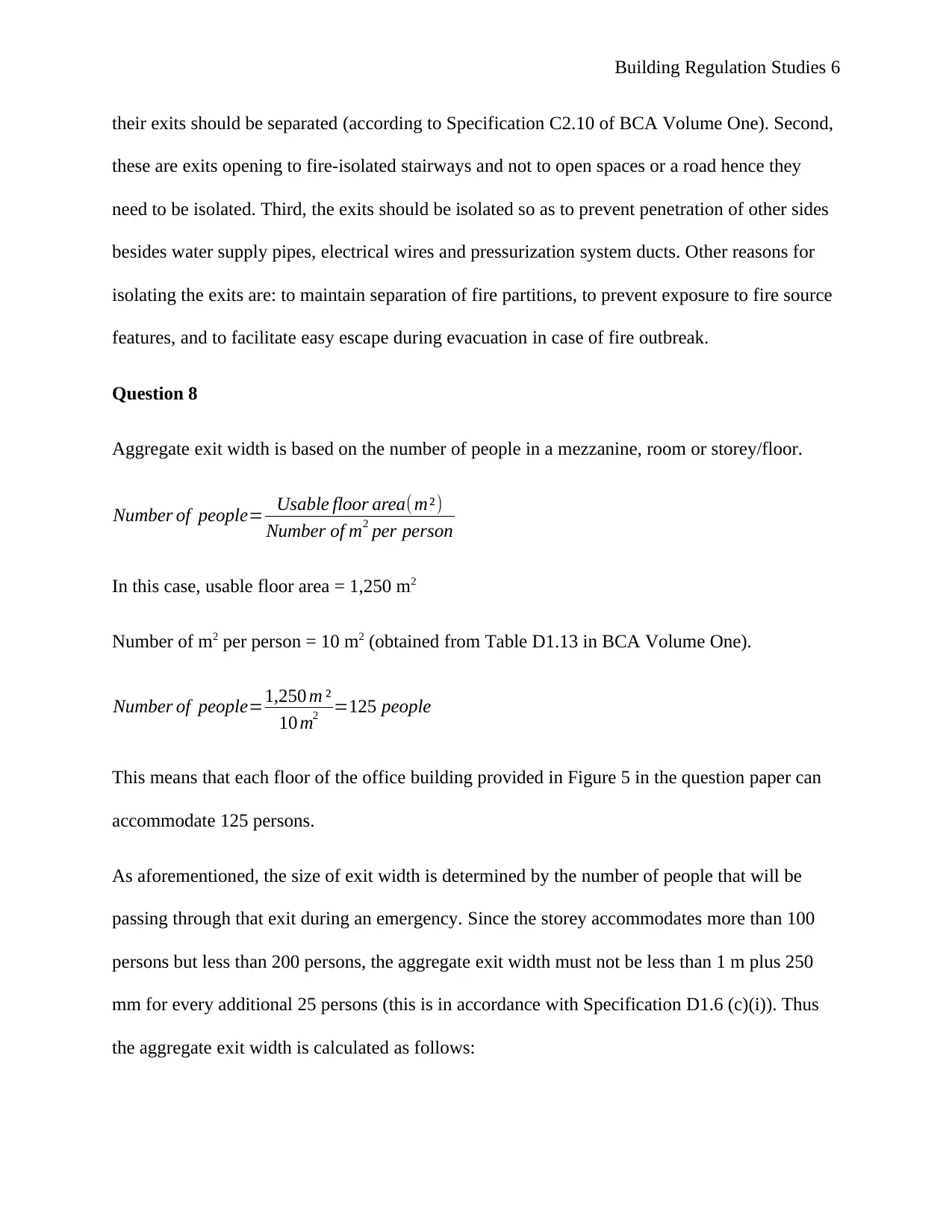
Building Regulation Studies 6
their exits should be separated (according to Specification C2.10 of BCA Volume One). Second,
these are exits opening to fire-isolated stairways and not to open spaces or a road hence they
need to be isolated. Third, the exits should be isolated so as to prevent penetration of other sides
besides water supply pipes, electrical wires and pressurization system ducts. Other reasons for
isolating the exits are: to maintain separation of fire partitions, to prevent exposure to fire source
features, and to facilitate easy escape during evacuation in case of fire outbreak.
Question 8
Aggregate exit width is based on the number of people in a mezzanine, room or storey/floor.
Number of people= Usable floor area(m²)
Number of m2 per person
In this case, usable floor area = 1,250 m2
Number of m2 per person = 10 m2 (obtained from Table D1.13 in BCA Volume One).
Number of people=1,250 m ²
10 m2 =125 people
This means that each floor of the office building provided in Figure 5 in the question paper can
accommodate 125 persons.
As aforementioned, the size of exit width is determined by the number of people that will be
passing through that exit during an emergency. Since the storey accommodates more than 100
persons but less than 200 persons, the aggregate exit width must not be less than 1 m plus 250
mm for every additional 25 persons (this is in accordance with Specification D1.6 (c)(i)). Thus
the aggregate exit width is calculated as follows:
their exits should be separated (according to Specification C2.10 of BCA Volume One). Second,
these are exits opening to fire-isolated stairways and not to open spaces or a road hence they
need to be isolated. Third, the exits should be isolated so as to prevent penetration of other sides
besides water supply pipes, electrical wires and pressurization system ducts. Other reasons for
isolating the exits are: to maintain separation of fire partitions, to prevent exposure to fire source
features, and to facilitate easy escape during evacuation in case of fire outbreak.
Question 8
Aggregate exit width is based on the number of people in a mezzanine, room or storey/floor.
Number of people= Usable floor area(m²)
Number of m2 per person
In this case, usable floor area = 1,250 m2
Number of m2 per person = 10 m2 (obtained from Table D1.13 in BCA Volume One).
Number of people=1,250 m ²
10 m2 =125 people
This means that each floor of the office building provided in Figure 5 in the question paper can
accommodate 125 persons.
As aforementioned, the size of exit width is determined by the number of people that will be
passing through that exit during an emergency. Since the storey accommodates more than 100
persons but less than 200 persons, the aggregate exit width must not be less than 1 m plus 250
mm for every additional 25 persons (this is in accordance with Specification D1.6 (c)(i)). Thus
the aggregate exit width is calculated as follows:
⊘ This is a preview!⊘
Do you want full access?
Subscribe today to unlock all pages.

Trusted by 1+ million students worldwide
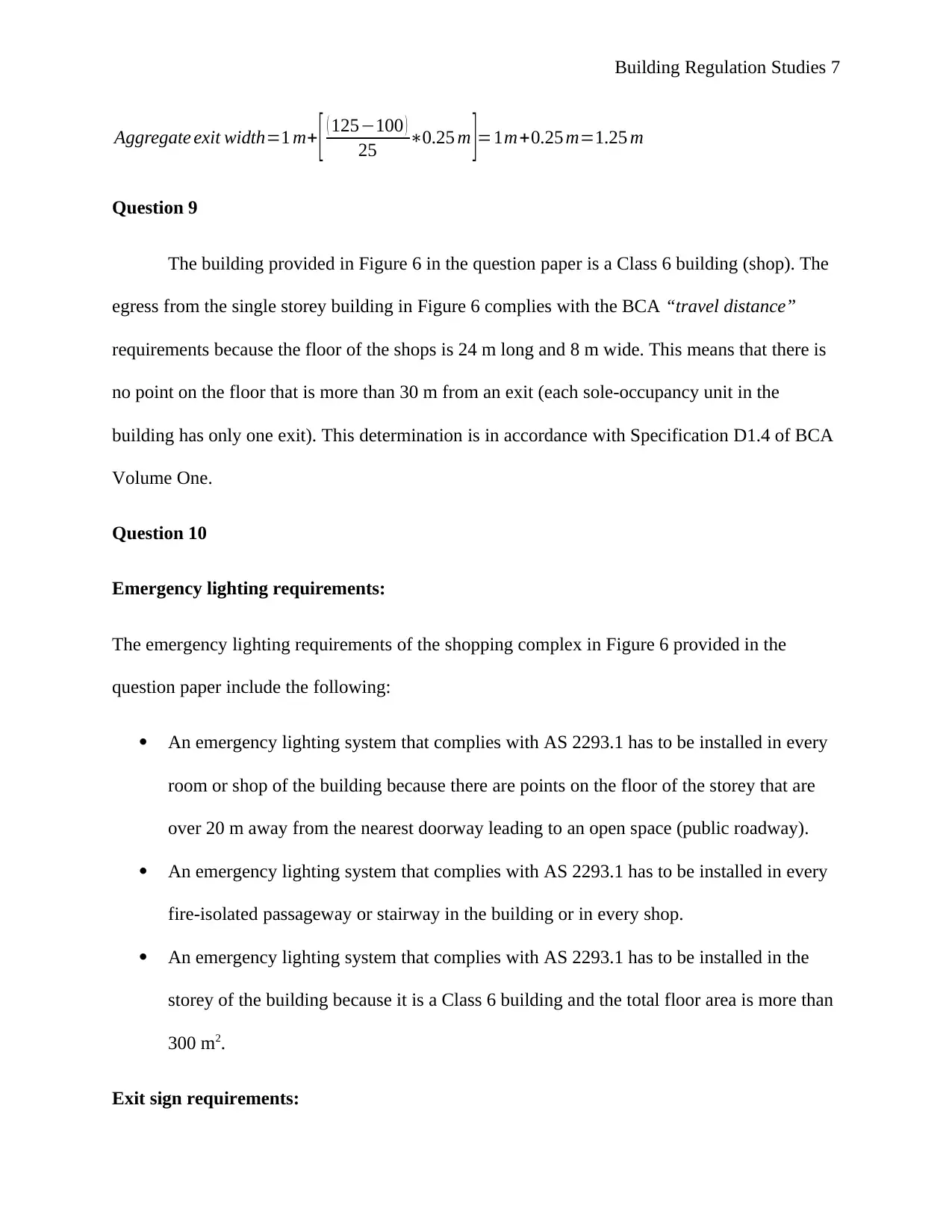
Building Regulation Studies 7
Aggregate exit width=1 m+ [ ( 125−100 )
25 ∗0.25 m ]=1m+0.25 m=1.25 m
Question 9
The building provided in Figure 6 in the question paper is a Class 6 building (shop). The
egress from the single storey building in Figure 6 complies with the BCA “travel distance”
requirements because the floor of the shops is 24 m long and 8 m wide. This means that there is
no point on the floor that is more than 30 m from an exit (each sole-occupancy unit in the
building has only one exit). This determination is in accordance with Specification D1.4 of BCA
Volume One.
Question 10
Emergency lighting requirements:
The emergency lighting requirements of the shopping complex in Figure 6 provided in the
question paper include the following:
An emergency lighting system that complies with AS 2293.1 has to be installed in every
room or shop of the building because there are points on the floor of the storey that are
over 20 m away from the nearest doorway leading to an open space (public roadway).
An emergency lighting system that complies with AS 2293.1 has to be installed in every
fire-isolated passageway or stairway in the building or in every shop.
An emergency lighting system that complies with AS 2293.1 has to be installed in the
storey of the building because it is a Class 6 building and the total floor area is more than
300 m2.
Exit sign requirements:
Aggregate exit width=1 m+ [ ( 125−100 )
25 ∗0.25 m ]=1m+0.25 m=1.25 m
Question 9
The building provided in Figure 6 in the question paper is a Class 6 building (shop). The
egress from the single storey building in Figure 6 complies with the BCA “travel distance”
requirements because the floor of the shops is 24 m long and 8 m wide. This means that there is
no point on the floor that is more than 30 m from an exit (each sole-occupancy unit in the
building has only one exit). This determination is in accordance with Specification D1.4 of BCA
Volume One.
Question 10
Emergency lighting requirements:
The emergency lighting requirements of the shopping complex in Figure 6 provided in the
question paper include the following:
An emergency lighting system that complies with AS 2293.1 has to be installed in every
room or shop of the building because there are points on the floor of the storey that are
over 20 m away from the nearest doorway leading to an open space (public roadway).
An emergency lighting system that complies with AS 2293.1 has to be installed in every
fire-isolated passageway or stairway in the building or in every shop.
An emergency lighting system that complies with AS 2293.1 has to be installed in the
storey of the building because it is a Class 6 building and the total floor area is more than
300 m2.
Exit sign requirements:
Paraphrase This Document
Need a fresh take? Get an instant paraphrase of this document with our AI Paraphraser
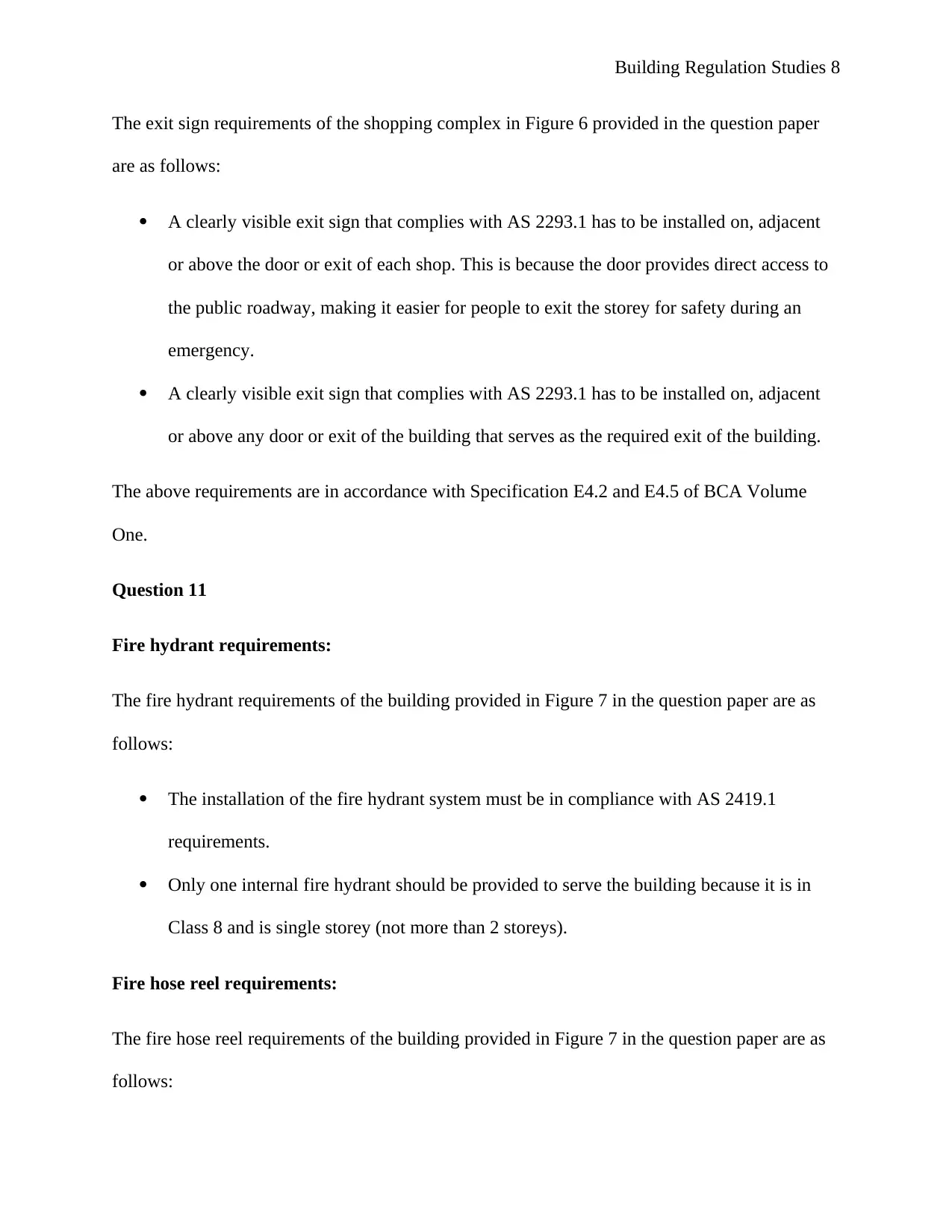
Building Regulation Studies 8
The exit sign requirements of the shopping complex in Figure 6 provided in the question paper
are as follows:
A clearly visible exit sign that complies with AS 2293.1 has to be installed on, adjacent
or above the door or exit of each shop. This is because the door provides direct access to
the public roadway, making it easier for people to exit the storey for safety during an
emergency.
A clearly visible exit sign that complies with AS 2293.1 has to be installed on, adjacent
or above any door or exit of the building that serves as the required exit of the building.
The above requirements are in accordance with Specification E4.2 and E4.5 of BCA Volume
One.
Question 11
Fire hydrant requirements:
The fire hydrant requirements of the building provided in Figure 7 in the question paper are as
follows:
The installation of the fire hydrant system must be in compliance with AS 2419.1
requirements.
Only one internal fire hydrant should be provided to serve the building because it is in
Class 8 and is single storey (not more than 2 storeys).
Fire hose reel requirements:
The fire hose reel requirements of the building provided in Figure 7 in the question paper are as
follows:
The exit sign requirements of the shopping complex in Figure 6 provided in the question paper
are as follows:
A clearly visible exit sign that complies with AS 2293.1 has to be installed on, adjacent
or above the door or exit of each shop. This is because the door provides direct access to
the public roadway, making it easier for people to exit the storey for safety during an
emergency.
A clearly visible exit sign that complies with AS 2293.1 has to be installed on, adjacent
or above any door or exit of the building that serves as the required exit of the building.
The above requirements are in accordance with Specification E4.2 and E4.5 of BCA Volume
One.
Question 11
Fire hydrant requirements:
The fire hydrant requirements of the building provided in Figure 7 in the question paper are as
follows:
The installation of the fire hydrant system must be in compliance with AS 2419.1
requirements.
Only one internal fire hydrant should be provided to serve the building because it is in
Class 8 and is single storey (not more than 2 storeys).
Fire hose reel requirements:
The fire hose reel requirements of the building provided in Figure 7 in the question paper are as
follows:
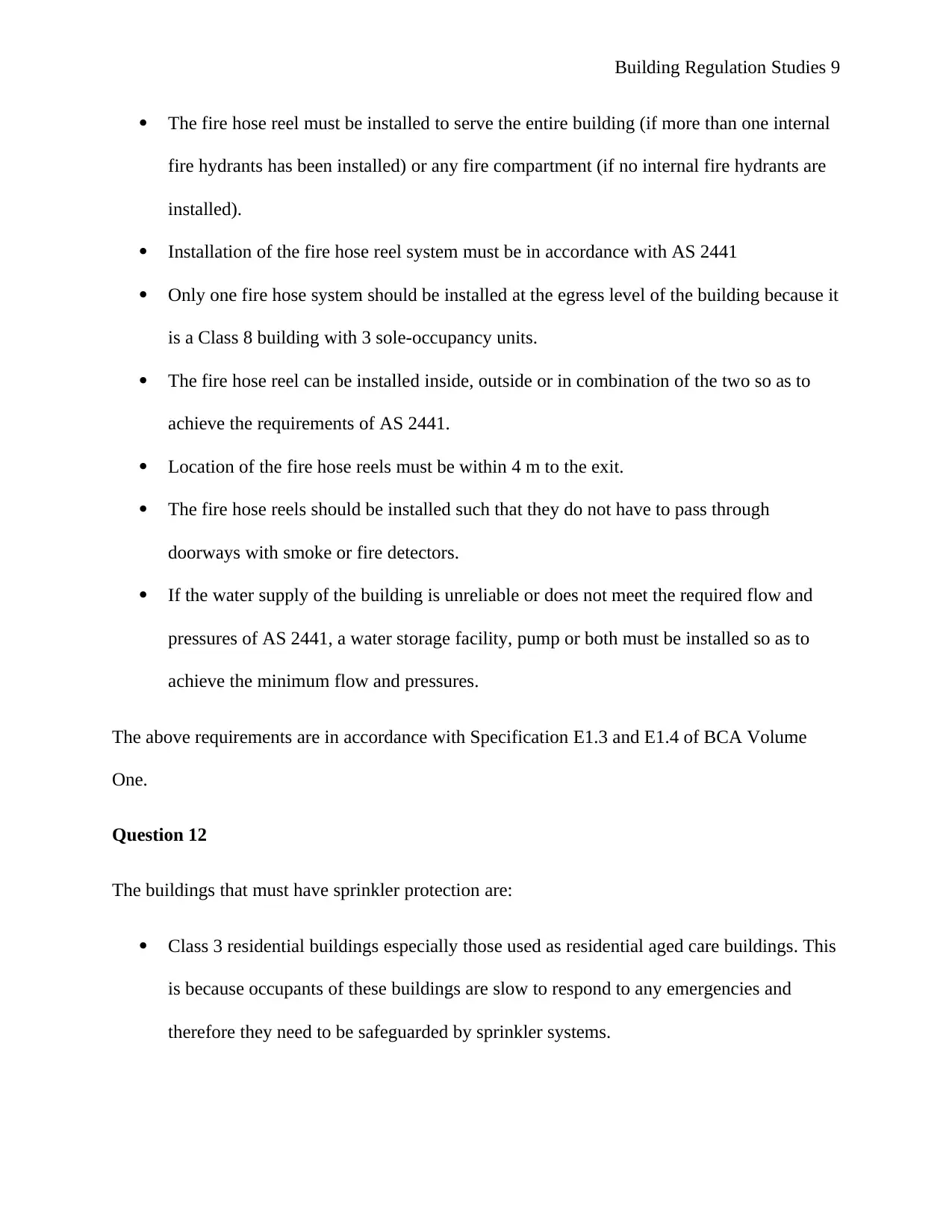
Building Regulation Studies 9
The fire hose reel must be installed to serve the entire building (if more than one internal
fire hydrants has been installed) or any fire compartment (if no internal fire hydrants are
installed).
Installation of the fire hose reel system must be in accordance with AS 2441
Only one fire hose system should be installed at the egress level of the building because it
is a Class 8 building with 3 sole-occupancy units.
The fire hose reel can be installed inside, outside or in combination of the two so as to
achieve the requirements of AS 2441.
Location of the fire hose reels must be within 4 m to the exit.
The fire hose reels should be installed such that they do not have to pass through
doorways with smoke or fire detectors.
If the water supply of the building is unreliable or does not meet the required flow and
pressures of AS 2441, a water storage facility, pump or both must be installed so as to
achieve the minimum flow and pressures.
The above requirements are in accordance with Specification E1.3 and E1.4 of BCA Volume
One.
Question 12
The buildings that must have sprinkler protection are:
Class 3 residential buildings especially those used as residential aged care buildings. This
is because occupants of these buildings are slow to respond to any emergencies and
therefore they need to be safeguarded by sprinkler systems.
The fire hose reel must be installed to serve the entire building (if more than one internal
fire hydrants has been installed) or any fire compartment (if no internal fire hydrants are
installed).
Installation of the fire hose reel system must be in accordance with AS 2441
Only one fire hose system should be installed at the egress level of the building because it
is a Class 8 building with 3 sole-occupancy units.
The fire hose reel can be installed inside, outside or in combination of the two so as to
achieve the requirements of AS 2441.
Location of the fire hose reels must be within 4 m to the exit.
The fire hose reels should be installed such that they do not have to pass through
doorways with smoke or fire detectors.
If the water supply of the building is unreliable or does not meet the required flow and
pressures of AS 2441, a water storage facility, pump or both must be installed so as to
achieve the minimum flow and pressures.
The above requirements are in accordance with Specification E1.3 and E1.4 of BCA Volume
One.
Question 12
The buildings that must have sprinkler protection are:
Class 3 residential buildings especially those used as residential aged care buildings. This
is because occupants of these buildings are slow to respond to any emergencies and
therefore they need to be safeguarded by sprinkler systems.
⊘ This is a preview!⊘
Do you want full access?
Subscribe today to unlock all pages.

Trusted by 1+ million students worldwide
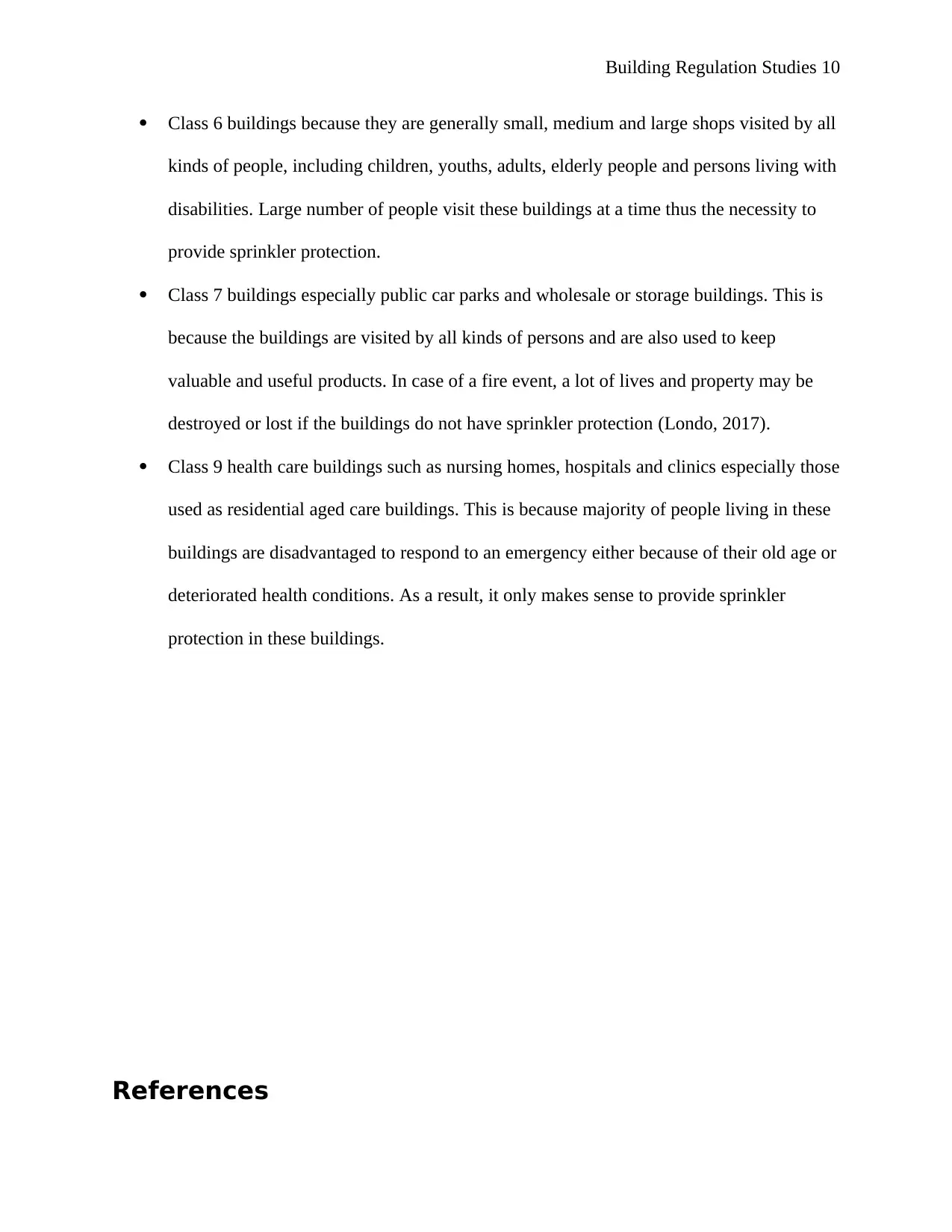
Building Regulation Studies 10
Class 6 buildings because they are generally small, medium and large shops visited by all
kinds of people, including children, youths, adults, elderly people and persons living with
disabilities. Large number of people visit these buildings at a time thus the necessity to
provide sprinkler protection.
Class 7 buildings especially public car parks and wholesale or storage buildings. This is
because the buildings are visited by all kinds of persons and are also used to keep
valuable and useful products. In case of a fire event, a lot of lives and property may be
destroyed or lost if the buildings do not have sprinkler protection (Londo, 2017).
Class 9 health care buildings such as nursing homes, hospitals and clinics especially those
used as residential aged care buildings. This is because majority of people living in these
buildings are disadvantaged to respond to an emergency either because of their old age or
deteriorated health conditions. As a result, it only makes sense to provide sprinkler
protection in these buildings.
References
Class 6 buildings because they are generally small, medium and large shops visited by all
kinds of people, including children, youths, adults, elderly people and persons living with
disabilities. Large number of people visit these buildings at a time thus the necessity to
provide sprinkler protection.
Class 7 buildings especially public car parks and wholesale or storage buildings. This is
because the buildings are visited by all kinds of persons and are also used to keep
valuable and useful products. In case of a fire event, a lot of lives and property may be
destroyed or lost if the buildings do not have sprinkler protection (Londo, 2017).
Class 9 health care buildings such as nursing homes, hospitals and clinics especially those
used as residential aged care buildings. This is because majority of people living in these
buildings are disadvantaged to respond to an emergency either because of their old age or
deteriorated health conditions. As a result, it only makes sense to provide sprinkler
protection in these buildings.
References
Paraphrase This Document
Need a fresh take? Get an instant paraphrase of this document with our AI Paraphraser
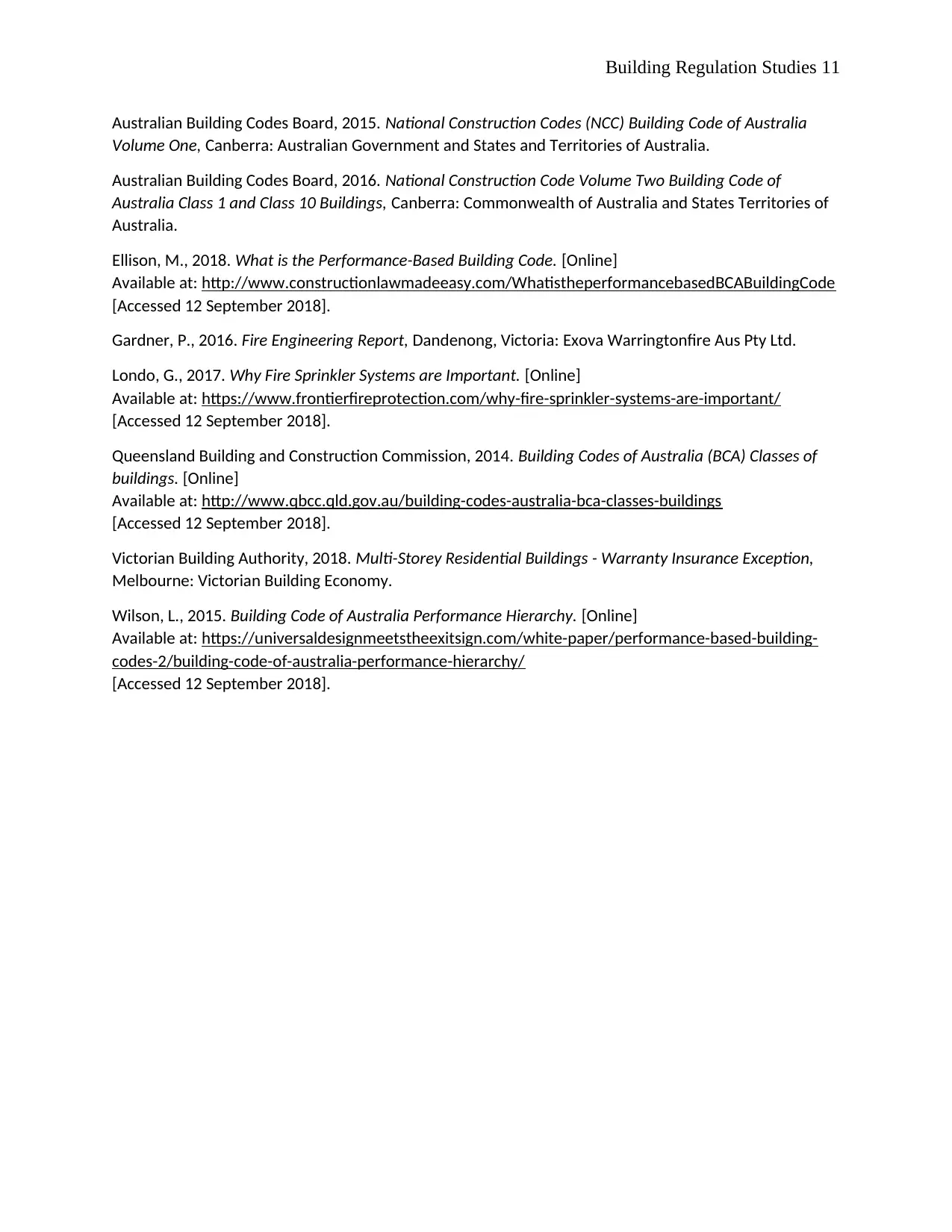
Building Regulation Studies 11
Australian Building Codes Board, 2015. National Construction Codes (NCC) Building Code of Australia
Volume One, Canberra: Australian Government and States and Territories of Australia.
Australian Building Codes Board, 2016. National Construction Code Volume Two Building Code of
Australia Class 1 and Class 10 Buildings, Canberra: Commonwealth of Australia and States Territories of
Australia.
Ellison, M., 2018. What is the Performance-Based Building Code. [Online]
Available at: http://www.constructionlawmadeeasy.com/WhatistheperformancebasedBCABuildingCode
[Accessed 12 September 2018].
Gardner, P., 2016. Fire Engineering Report, Dandenong, Victoria: Exova Warringtonfire Aus Pty Ltd.
Londo, G., 2017. Why Fire Sprinkler Systems are Important. [Online]
Available at: https://www.frontierfireprotection.com/why-fire-sprinkler-systems-are-important/
[Accessed 12 September 2018].
Queensland Building and Construction Commission, 2014. Building Codes of Australia (BCA) Classes of
buildings. [Online]
Available at: http://www.qbcc.qld.gov.au/building-codes-australia-bca-classes-buildings
[Accessed 12 September 2018].
Victorian Building Authority, 2018. Multi-Storey Residential Buildings - Warranty Insurance Exception,
Melbourne: Victorian Building Economy.
Wilson, L., 2015. Building Code of Australia Performance Hierarchy. [Online]
Available at: https://universaldesignmeetstheexitsign.com/white-paper/performance-based-building-
codes-2/building-code-of-australia-performance-hierarchy/
[Accessed 12 September 2018].
Australian Building Codes Board, 2015. National Construction Codes (NCC) Building Code of Australia
Volume One, Canberra: Australian Government and States and Territories of Australia.
Australian Building Codes Board, 2016. National Construction Code Volume Two Building Code of
Australia Class 1 and Class 10 Buildings, Canberra: Commonwealth of Australia and States Territories of
Australia.
Ellison, M., 2018. What is the Performance-Based Building Code. [Online]
Available at: http://www.constructionlawmadeeasy.com/WhatistheperformancebasedBCABuildingCode
[Accessed 12 September 2018].
Gardner, P., 2016. Fire Engineering Report, Dandenong, Victoria: Exova Warringtonfire Aus Pty Ltd.
Londo, G., 2017. Why Fire Sprinkler Systems are Important. [Online]
Available at: https://www.frontierfireprotection.com/why-fire-sprinkler-systems-are-important/
[Accessed 12 September 2018].
Queensland Building and Construction Commission, 2014. Building Codes of Australia (BCA) Classes of
buildings. [Online]
Available at: http://www.qbcc.qld.gov.au/building-codes-australia-bca-classes-buildings
[Accessed 12 September 2018].
Victorian Building Authority, 2018. Multi-Storey Residential Buildings - Warranty Insurance Exception,
Melbourne: Victorian Building Economy.
Wilson, L., 2015. Building Code of Australia Performance Hierarchy. [Online]
Available at: https://universaldesignmeetstheexitsign.com/white-paper/performance-based-building-
codes-2/building-code-of-australia-performance-hierarchy/
[Accessed 12 September 2018].
1 out of 11
Related Documents
Your All-in-One AI-Powered Toolkit for Academic Success.
+13062052269
info@desklib.com
Available 24*7 on WhatsApp / Email
![[object Object]](/_next/static/media/star-bottom.7253800d.svg)
Unlock your academic potential
Copyright © 2020–2025 A2Z Services. All Rights Reserved. Developed and managed by ZUCOL.





